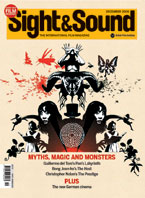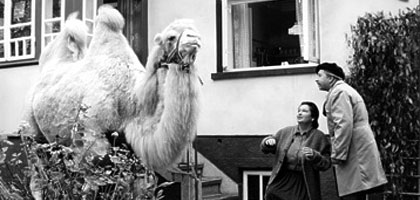Primary navigation


Tim Lucas enjoys a delightful realisation of an unfilmed Krzysztof Kieslowski screenplay
Jerzy Stuhr; Poland 2000: Milestone Films/Region1; Aspect Ratio: 1.33:1; Features: director interview, making-of, trailer, and DVD-Rom press kit
Based on an unfilmed screenplay by the late Krzysztof Kieslowski, The Big Animal (Duze zwierze) is a low-key miracle of allegoric purity. It's a bittersweet story as simply told as one you might find in an illustrated children's book, yet fraught with wisdom about the obstacles to happiness in the adult world. If it falls somewhat short of perfection, it's nevertheless a qualified triumph for director-star Jerzy Stuhr, best known to English audiences as the lead in Kieslowski's Camera Buff (1979) and a prominent player in Dekalog (1988) and Three Colors: White (1993).
Stuhr gives a deft performance as Zygmunt Sawicki, a small-town bank clerk who, with his wife, Marysia (Anna Dymna), is surprised one evening by the appearance of a camel in his front yard. Having been abandoned bya circus, the camel is adopted by Zygmunt, who dons a worldly beret and parades the animal through the town like the magical thing it is. His neighbours react with initial astonishment but quickly want a piece of it, offering to buy it and bringing Zygmunt proposals for its commercial and exploitative use. The local kids, who spit and throw apples at it, turn friendlier when Marysia, their schoolteacher, holds a name-the-camel contest, but Zygmunt finds their suggestions undignified. When the contest peters out with no winner, and the Sawickis pooh-pooh a not-so-subtle suggestion from the local police that they contribute the camel to the pool of the upcoming state lottery, they find their pride reprimanded with tax hits, court summonses, official condemnations for building a stable on their property ("conspicuous consumption"), and expulsion from the woodwind section of the town orchestra. Suddenly, the camel is branded as creating "unwanted sensation" and as being "of no use to the community", and it becomes a struggle for the couple to keep it.
Shot in soft, high-contrast black-and-white (think Freddie Francis' work on The Elephant Man), The Big Animal surely wields the Kieslowski touch. Partly because of the decision not to film in colour, it strikes an almost preposterously profound (yet amusing) existential chord with its very first shot. Without this opening image, tragicomically depicting the abandonment of the camel, Stuhr's film might have been more literally about an actual camel - a kind of Clarence The Cross-Eyed Lion for the 21st century. But with this shot, it becomes, not unlike Three Colors: Red, a story that simultaneously occupies realistic and otherly planes. The animal embodies the maxim that one man's trash is another man's treasure; it can also be read as a metaphor for material goods, the sin of pride, the preciousness of life, the right of individuals to take pleasure in something "useless" without society's approval, the intrusion of government into the pursuit of happiness, or whatever you like. Whichever interpretation you opt for, the story somehow magically conforms to that meaning and satisfies, despite some weariness in the final stretch. For those who are tempted to see this as a pro-individual, anti-socialist statement, the final scene may prove as surprising as it is masterfully subtle.
Milestone Films presents this delightful, shortish feature (it's less than 75 minutes long) in a standard aspect ratio befitting the film's Telewizja Polska (Polish Television) origins. The look of the presentation is appealing, as is the Dolby 2.0 stereo mix of the Polish-language soundtrack. The English subtitles are a trifle awkward: a one-word sign held up to the view of the Sawickis is subtitled as "out" but would make more sense as "leave" or "go", and a single instance of strong profanity is subtitled with ellipses ("f***"), as if the translator refused to fill in the blanks. The extras consist of a bland trailer that tells too much of the minimal story; a five-minute making-of (actually a Stuhr interview with film clips) derived from a Polish TV infotainment show; and Controlled Testimonies, a half-hour interview of Stuhr by Nina Terentiew, the programme director of Polish television channel TVP2. Controlled Testimonies offers nothing on The Big Animal itself, but provides welcome background on the film-maker, who speaks in a likeable, down-to-earth manner about everything from meeting Kieslowski to the art of making spaghetti, over the muted groovings of a jazz combo.